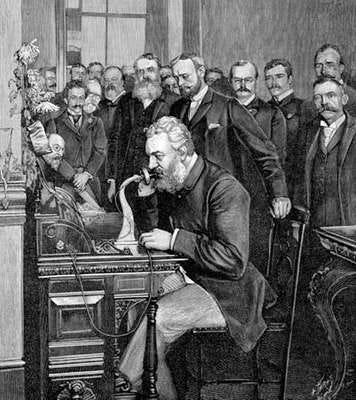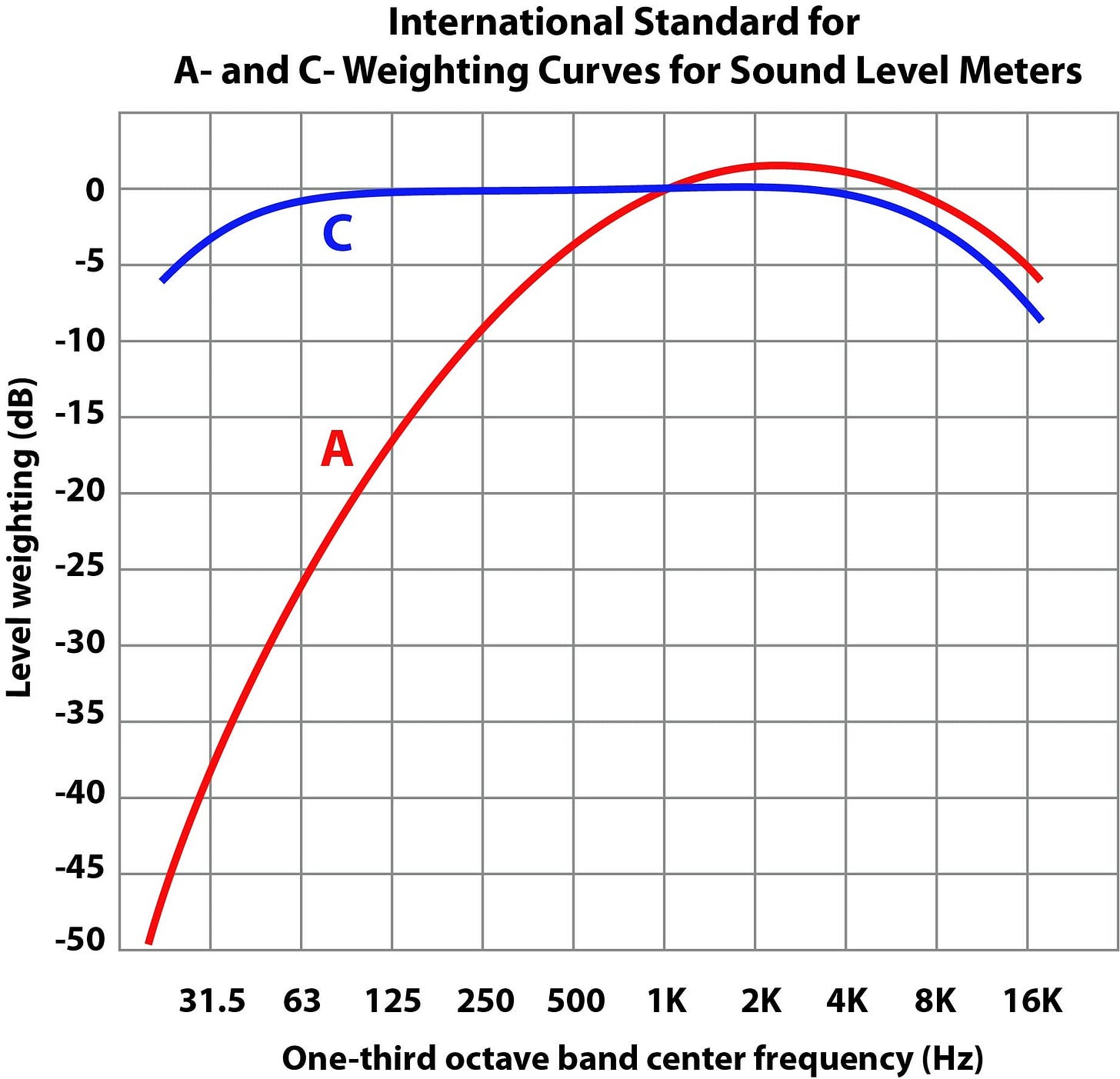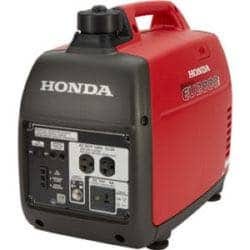Generator Noise : A Deep Dive into SPL!
Here's Part 2 of my generator noise study. Yup, it does include all the math!
Generator Noise Pollution – Part 2
I’ve had several recent emails about noisy generators bothering nearby campers. I guess it’s that time of year when everyone needs air conditioning in their RVs and no sane amount of solar panels and house batteries have enough power to run an air conditioner for more than a few minutes. So unless you’re connected to shore power, you need a generator.
ALL generators make noise, some more than others. And the quieter the generator the more it seems to cost. So is paying 3 or 4 times as much for a quiet generator compared to a cheap, noisy one worth the investment? And is there anything else to be gained besides lower noise from a more expensive genny? I’ll do an in-depth analysis of different brand generators in a future article, but for now we’re going to focus on the noise factor. But first we have to explain dB, deciBels, SPL and weighing curves.
A few definitions…
Before we get started let me assure you that I know what I’m talking about when it comes to deciBels and sound levels in general. In my day job I teach university-level classes on audio acoustics, sound pressure levels and music mixing. This is, in fact, how sound actually works. If you missed it, please read Part 1 on the ABC’s of Generator Noise HERE.
Who is this SPL you speak of, and what’s a dB?
Glad you asked. A dB is a deciBel, which is a combination of the words deci and Bel. The deci means 1/10th, as in decimal place, or like a dime is 1/10th of a dollar. So a deci-Bel is 1/10th of a Bel. But what is a Bel? Well, it’s a ratio of power measurement named for one of America’s most famous inventors, Alexander Graham Bell, the father of the telephone. (As a side note, Bell invented the telephone in part to assist his ailing mother who was deaf. But that’s another story.)
We typically use the term dB (deciBel) for sound level measurements since that gives us a much more usable number than a Bel, which is huge. I won’t bore you with all the calculations, but know that a dB is simply a ratio of power, and that +3 dB equals a doubling of power, +6 dB equals 4 times the power, and +10 dB equals 10 times the power. Subtracting deciBels by using a minus sign halves the power, etc… So -3 dB is 1/2 the power, -6 dB is 1/4 of the power, and -10 dB is 1/10 of the power. Here’s a quick chart that makes the dB relationship clear.
Chart it!
+3 dB = 2 x the power -3 dB = 1/2 the power
+6 dB = 4 x the power -6 dB = 1/4 the power
+10 dB = 10 x the power -10 dB = 1/10 the power
+20 dB = 100 x the power -20 dB = 1/100 the power
+30 dB = 1,000 x the power -30 dB = 1/1,000 the power
+40 dB = 10,o00 x the power -40 dB = 1/10,000 the power
This is what’s called a logarithmic relationship, just like the earthquake Richter Scale. And log ratios are really handy since they make it easy to compare power levels with simple addition and subtraction. But before we get to that we have to define SPL, which stands for Sound Pressure Level. You’ll often see the term SPL combined with dB for generator ratings, as in 68 dB SPL. Many times the ad will simply say 54 dB, but that’s a nonsense number since 54 dB is a ratio without any reference power level to compare against.
Reference it!
SPL does indeed have a power reference level which is 20 micropascals of sound pressure. So 0 dB SPL is 20 micropascals of acoustic pressure, which is the quietest sound that a human can hear under perfect conditions. This means that +3 dB SPL would be 2 times the power, +6 dB SPL would be 4 times the power, +10 dB SPL would be 10 times, +20 dB SPL would be 100 times, +30 dB would be 1,000 times and +40 dB SPL would be 10,000 times the power. And yes, 60 dB SPL would be 1,000,000 times the power of 0 dB SPL. That’s indeed 1 million times the reference level of 0 dB SPL.
How loud does it sound?
Now, it doesn’t “sound” 1 million times louder (thankfully) since our own own hearing is logarithmic. That is, every time you add 3 dB of power the sound level gets just noticeably louder, and every 10 dB makes it sound twice as loud. So if you’re comparing two generators, one that’s 54 dB SPL versus another one that’s 64 dB SPL, the 64 dB one sounds twice as loud to your ears, but it’s really putting out 10 times as much acoustic energy (noise).
Now Hear This!
If you want to hear an example of this, here’s a video comparing the 16 dB difference in sound levels between a 52 dBA inverter generator and a 68 dBA open-frame contractor generator.
This video shows two different generators running. I’ve calibrated the audio playback so you can hear the actual sound level difference between a 3,000 watt Honda EU3000is generator and an equivalent 3,000 watt open-frame contractor generator. As you can hear, there’s a HUGE difference in sound levels between the two different types of generators.
Other test parameters
And one more thing to know about how generator levels are tested. As you move farther away from anything making noise, the sound level drops off at a very predictable level, with each doubling of distance causing another 6 dB (1/4) drop in level. So if you use an SPL meter and measured a generator at 80 dB SPL from 1 foot away, then it will read 74 dB at 2 ft., 68 dB at 4 ft., 62 dB at 8 ft., 56 dB at 16 ft., and 50 dB at 32 ft. (This is outdoors without any wall reflections.) The standard distance for generator SPL testing is 7 meters or 23 feet. If you see someone in a video measuring the sound level of a generator from 6 inches away, then they have NO idea what they’re talking about.
Don’t believe everything you read…
Sorry, but the internet is full of misinformed “experts” who can’t do the dB math. If they can’t show the calculations to prove how something works, then they should shut up. As you can see, I always show my work.
Meter it!
There’s one more setting to consider, the A/weighted curve versus the C-weighted curve on an SPL meter. The C-weighted curve has a flat frequency response which includes all the bass frequencies in the measurement. But the A-weighted curve ignores most of the low frequency sounds. We generally use the C-weighted setting for room calibration, but the A-weighted setting on an SPL meter is a better indicator of hearing damage due to loud sounds. The generator industry uses the A-weighted curve at a distance of 23 feet away from the generator for its SPL readings.
Generally we use the A weighted scale on an SPL meter for these types of measurements since it ignores a lot of the low-frequency (bass) energy. So if you see something like 68 dBA they really mean 68 decibels of Sound Pressure Level using the A weighting curve, which is a standardized way to measure apparent sound levels. Nobody uses the C-Scale for this sort of sound level measurement since it will often read 10 dB (or more) louder for the same sound source compared to the A-scale. If you’re using an SPL meter app on your phone, be sure to set it to the A Weighed curve to be comparing measurements equally.
A tale of two gennys
I’m going to divide portable generators into two basic categories: open-frame/AC, and suitcase/DC-inverter. Of course there are many sub-categories, but these two are the most important ones when discussing noise levels.
An open-frame/AC generator is what we usually call a contractor generator. They typically have a steel-tube frame in a box shape with an open gasoline engine and generator mounted inside. The gas engine and generator itself generally have some sort of rubber mounts to help isolate the vibration of the engine from whatever it’s sitting on, just like the motor mounts in your car.
In addition to having all the whirling bits out in the open (which is where a lot of the noise comes from in addition to the muffler), these are AC generators, which means the engine needs to spin the generator rotor at a constant speed all the time to make 60 Hz Alternating Current. Slow the engine down to idle and the AC frequency will drop from 60 Hz down to maybe 10 Hz or so, which is not good power. So the gasoline engine needs to run at 3,600 RPM all the time, even if the generator only needs to supply a few watts.
This contributes to two problems: an AC generator makes constant noise under all load conditions, and it has a higher fuel usage rate per hour compared to a DC/inverter generator, even when the AC generator is only powering a few LED bulbs.
AC/DC Inverter (Voltage… not the group)
Enter the DC/inverter “suitcase” generators from Honda, Yamaha and others such as Champion. These are completely different from a standard contractor AC generator for two important reasons. First of all, they’re completely enclosed with a lot of sound deadening material on the exterior panels. This serves to keep whatever sound the engine and spinning parts make inside of the box. Of course this adds to the weight and cost of this style generator, but it does reduce the basic noise levels by at least 10 decibels (68 dB – 58 dB = 10 dB). And that’s an energy factor of 10 times (1,000%), which is significant.
How does eco-throttle work?
But the real SPL (and fuel) savings come from the fact that these are not AC generators at all. Nope, they’re really a gasoline engine spinning an alternator which makes 12 volts of DC just like in your car. Then that 12 volts of DC is turned into 120 volts AC by an inverter, just like in your RV. This allows the gasoline engine to throttle back to idle in “Eco” mode when you’re not pulling much power, but then speed up to full RPM (and power) when the inverter needs to supply full wattage to the load (like your hair dryer). That suggests that an inverter generator can use half the gasoline of an AC contractor generator since 120-volt loads in an RV are rarely constant, and vary a lot as different appliances are switched on and off.
Plus, the inverter (being an electronic device under computer control) is extremely stable in terms of frequency and voltage, with hardly any change even when going from 0% to 100% of rated load. And the Honda and Yamaha generators use sine-wave inverters with extremely low harmonic distortion. In fact, many of my pro-sound colleagues say the AC power coming from their Honda inverter generators is cleaner than what they get from the power line. I really can’t argue with them… a Honda inverter generator does, in fact, make cleaner power than the power company can supply you with.
Genny, Genny, who can I turn to? (867-5309)
So what’s your choice? A cheap but loud contractor generator that uses a lot of gasoline, or an expensive but really quiet inverter generator that sips gasoline especially in eco-throttle mode? Yes, I know that the price different is staggering with a Honda EU2000i costing around $1,000 and a contractor generator of the same wattage costing around $250. And while Honda is the gold standard for inverter generators (it really is), there are a number of wannabe inverter generators costing half of the price of a Honda. So are they just as quiet and do they last as long as a Honda? And how quiet should a generator be so as not to disturb others at a campground? More on those topics next month in Part II of this series.
Caveat Emptor (Buyer Beware)
Should RV supply stores be selling loud contractor generators?
I can guess what a lot of you are going to say about this: That RV stores should not be selling contractor generators that are too loud for use in a campground. But I’m going to cover this from a different angle.
As you can see from the first part of this article on dB levels, Sound Pressure Levels are a difficult concept to understand. So if a manufacturer tells a distributor that their generator is “RV Ready,” then the RV store will stock them. And if it’s in stock, then the RV salesman is going to parrot whatever the promotional literature says and tell you it will work just fine in a campground. After all, many times there’s a sticker that says something like, “It’s quiet as a conversation since it’s only 68 dBA,” which it certainly is not. I really think this is largely the manufacturers’ fault for creating misleading advertising. Time for each of you to study up and make your own informed decisions on generators.
Let’s play safe out there… Mike










While I appreciate quiet generators a lot, it turns out it's not just the sound level that can be annoying. I had a camping trip almost ruined because I was in a site between two sites that ran their Yamaha generators all day, even when they weren't there. (Traveling together, they had matching trailers, generators, and dog enclosures.) There wasn't an open spot for me to move to for the rest of the stay, and I couldn't abandon my husband who was off backpacking. The campground only has nighttime quiet hours, no limits on generators outside of that - hoping it will have changed for this year.
The all-day droning made me crazy. Even my white noise machine didn't help. The camp host commented on it all on my last day there.
We have a propane generator slung under our van. Is there any way to make it quieter?